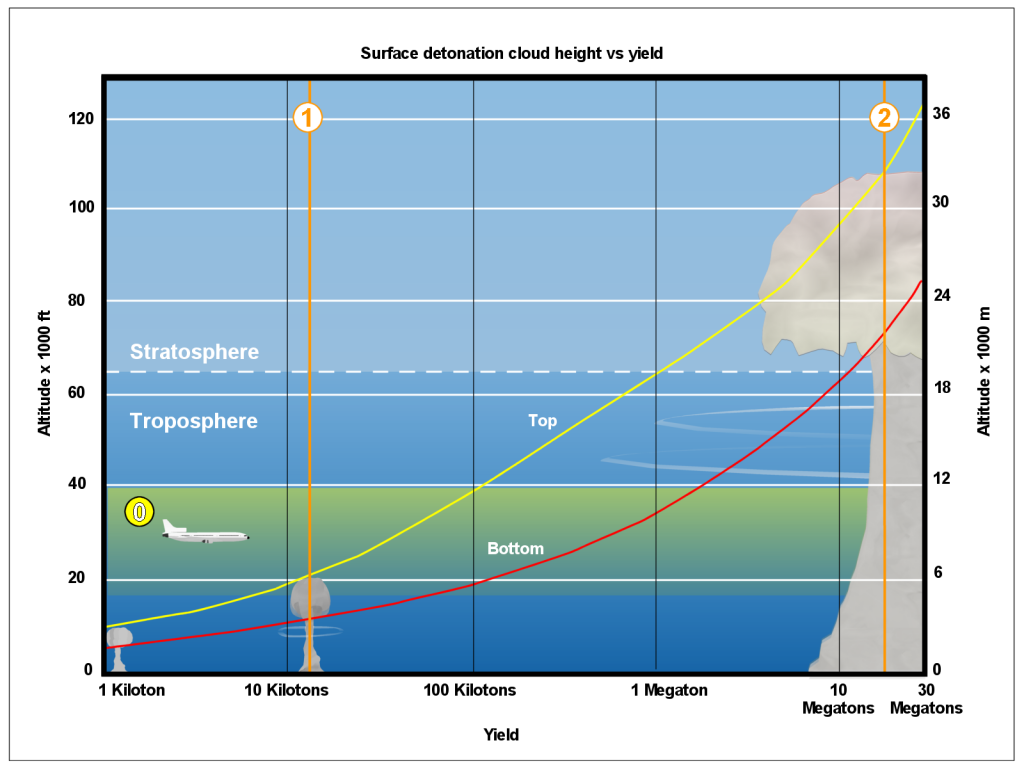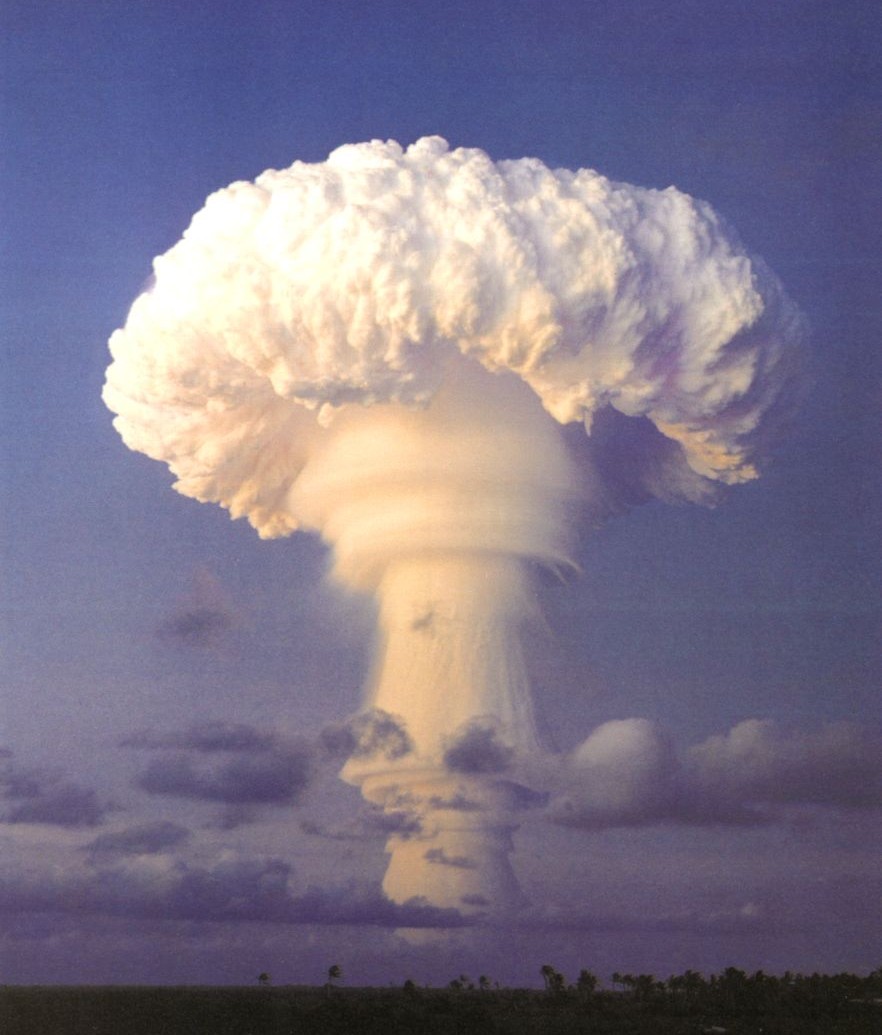.......................................................................................................................
End
Times Truth
The
effects of nuclear weapons have been studied extensively since the initial use
of atomic bombs upon Japan in 1945.
As the
pillars of smoke rose above the decimated cities of Hiroshima and Nagasaki and
formed the characteristic mushroom clouds thousands of feet into the air, the
danger of international conflict changed forever.
Knowledge
gained from the survivors of these bombs and from research done on the many
test explosions performed in the decades following World War II indicated that
the threat of nuclear war extends to every aspect of life on Earth.
One of
the best compilations of the effects of nuclear weapons comes from a study
published in 1977 by the United States Department of Defense (edited by Samuel
Glasstone and Philip Dolan), which was updated several times as advances in
thermonuclear fusion bombs were made and tested.
There
are also excellent books that have been published on this topic as well as
numerous Internet sites that have compiled information on the physical and
medical effects of nuclear war.
Many of
these references are cited in this section and in the sections which follow.
Probably
the first characteristic that immediately comes to mind regarding the effects
of nuclear war is the surging clouds of smoke and debris that quickly rise up
to thousands of feet in the atmosphere after a nuclear blast.
The
majority of people would recognize a nuclear explosion solely as a result of
seeing this distinctive “mushroom cloud” reaching far above the earth.
These
plumes of smoke are formed through blast excavation of soil and earth at the
point of detonation in addition to the pulverization of buildings, plants, and
other structures on the ground.
The
initial nuclear fireball creates a region of super-heated air having low
density, which because of its extreme buoyant mass creates a region of
turbulence that rapidly rises into the atmosphere.
These
turbulent vortices form the upper mushroom part of the cloud, which has the
characteristic of ballooning outward with bellows of smoke and debris curling
downward at its outer edges as it rises upward.
In
addition, the strong updraft from the ascending fireball creates an internal
suction, causing cooler air to quickly move in from all surrounding directions
at velocities that can exceed hurricane-strength winds, which then rise within
a central column of ash and smoke.
In
fact, the largest nuclear weapons can produce updraft winds within the central
column that are in the range of 600-800 miles per hour.
This
upward flow rapidly forms the stem of the mushroom cloud, and its thickness and
ultimate height are indicative of the size of the nuclear explosion.
Within
seconds the mushroom cloud can rise above the typical cumulus cloud height and
after about 10 minutes it can extend up into the stratosphere with a tremendous
ascending flow pulling the smaller particles of debris, soot, smoke, and ash
along with it.
Thus,
the full mushroom cloud effect of a nuclear blast typically takes only moments
to form from a ground burst or a near-ground explosion, but can create a
massive column of smoke extending from the surface even up into the
stratosphere.
The major
component of these mushroom clouds is smoke. Smoke can be formed from the
combustion of any flammable organic materials (carbon based), and it becomes
sootier as the temperature of combustion increases.
In the
center of a nuclear explosion, the temperatures are far greater than typical
fires or explosions.
At a
temperature of millions of degrees within the fireball, any flammable items
will be instantly transformed into tiny particles of soot.
These
particles are largely made up of amorphous elemental carbon with sizes in the
range of nanometers to micrometers in size (from: Environmental
Consequences of Nuclear War Volume I: Physical and Atmospheric Effects, Ch. 3,
p. 40).
At this
size, they can easily be carried upward with the rising fireball.
In addition,
the closer the blast is to the Earth’s surface the more dirt and debris can be
carried up by the inflow and up-flow of winds.
A
ground blast will often carve out a massive crater and cause strong inflowing
winds that can pick up the pulverized debris from miles around and form a thick
dark column leading up to the ascending fireball.
The
final height of the pillar of smoke is dependent on the yield of the nuclear
explosion and the prevailing winds in the atmosphere. For weapons of about 1 MT
yield exploding near the surface, the mushroom cloud top can reach over 12
miles high.
For the
largest thermonuclear fusion bombs tested, the cloud can actually reach over 25
miles high, which is about 4 times the cruising altitude of a typical passenger
jet.
Thus,
one of the initial effects of nuclear war are the giant columns of smoke
emanating from each blast.
However,
in a full-scale war these mushroom clouds would become much more than just
signatures of individual explosions.
Most of
the primary targets that would be hit by the NATO countries and the Russian
Alliance would involve multiple explosions extending over hundreds of square
miles over each city and also hitting military installations and other
important energy and industrial facilities.
Huge
amounts of smoke and debris coming from a full nuclear exchange involving thousands
of explosions would coalesce and blanket large regions of the world and be a
significant cause of death, especially for those downwind or within the fallout
range of ground zero.
Even
the Bible mentions smoke as being a major characteristic of the final battles.
When
the Kings of the East attack Israel at the end, John tells us that one-third of
mankind will be killed by the fire, smoke, and brimstone, which results from
their onslaught (Revelation 9:13-18).
Joel,
however, gives us the best description of what a nuclear explosion might look
like to anyone observing it.
Thousands
of years ago he predicted that at the end of the age the Lord would show…
“… wonders in the heavens and in the earth; blood, and fire, and
pillars of smoke.” Joel 2:30
When a
correspondent for the New York Times witnessed the bombing of Nagasaki on
September 9, 1945, while flying in an accompanying plane next to the main
bomber, he described the event as producing a “pillar of purple fire” and as “a
giant mushroom that increased the height of the pillar to a total of 45,000
feet (see: http://en.wikipedia.org/wiki/Mushroom_cloud and
the publication Eyewitness Account of Atomic Bomb
Over Nagasaki, by William Laurence, War Department, Bureau of Public
Relations, 1945).
It is
incredible that even after the first nuclear weapons were used on populated
cities the initial reaction from an eye-witness included a description matching
exactly what Joel predicted: pillars of smoke.
God was
revealing through those events the eventual fulfillment of end times prophecy
decades before it would come to pass — not only demonstrating the accuracy of
the Bible in predicting the future, but giving our generation a warning that
there is not much time left before this dire holocaust comes upon the world and
Christ Returns.
When
the superpowers eventually engage in the final nuclear conflict in the last
days, gigantic pillars of smoke will rise far above the earth and coalesce into
dark blankets of death, which will darken the skies and rain radioactive
fallout onto almost every part of the globe.
Fine
particles and smoke will remain suspended in the upper regions of the
atmosphere for extended periods, causing significantly decreased sunlight
reaching the Earth’s surface and affecting plant growth and temperatures
worldwide (more on these points later).
According
to early research into the mushroom clouds and the enormous amount of smoke,
soot, and ash which would be injected into the upper atmosphere, the global
consequences will be disastrous for the world’s ecosystem.
Turco
et al., 1990, attempted to catalog all of the flammable materials that would be
ignited during a likely nuclear exchange between the major superpowers [Turco,
R.P., Toon, O.B., Ackerman, J.B., Pollack, J.B., and Sagan, C. (1990) Climate
and Smoke: An appraisal of nuclear winter, Science 247, 166-176; also see their
previous publication in Science, called the TTAPS study from the initials of
the authors: Science 222, 1283-1292 (1983)].
These
flammable materials would contribute significant sources of secondary smoke
that would continue to burn and be injected into the air in the days, weeks,
and months following the initial nuclear explosions.
The
authors predicted that from 6,740 to 13,480 teragrams (Tg = 1012 gm
= trillion grams) or 6.7 to 13.4 quadrillion grams of flammable materials would
burn and produce supplemental sources of smoke, soot, and ash after the initial
nuclear exchange between the Russian alliance and the NATO nations.
This
includes building materials such as wood, lumber, cellulosic byproducts, and
interior furnishings; primary and secondary petroleum products; plastics and
polymers; asphalt roofing materials; and plants and vegetation (grasses, weeds,
bushes, and trees).
Therefore,
the total quantity of flammable materials that would burn in a war between
Russia and the West was estimated to be from 6.7 to 13.4 trillion kilograms (or
14.8 to 29.7 trillion pounds).
Seeing
that populations and cities have grown significantly since the TTAPS study was
published, the amount of flammable materials that could ignite today would
likely exceed the high end of this estimate.
Thus,
the total effects of nuclear war would include both the smoke and debris from
the initial explosions creating thousands of mushroom clouds as well as the
subsequent smoke and soot from thousands of fires consuming trillions of pounds
of combustible materials.
In his
article The Nuclear Winter, Carl Sagan stated:
“A more or less typical strategic warhead has a yield of 2
megatons, the explosive equivalent of 2 million tons of TNT. But 2 million tons
of TNT is about the same as all the bombs exploded in World War II — a single
bomb with the explosive power of the entire Second World War but compressed
into a few seconds of time and an area 30 or 40 miles across…
“In a 2-megaton explosion over a fairly large city, buildings
would be vaporized, people reduced to atoms and shadows, outlying structures
blown down like matchsticks and raging fires ignited.”
Amazingly,
the regions of the world that the TTAPS study analyzed perfectly correspond to
the countries predicted in the Bible to be involved in the initial battles
during the Great Tribulation.
Through
these studies, the Lord has provided knowledge and understanding ahead of time
on the effects of nuclear war to warn us of what will soon come to pass.
It is
important to also realize that there is still time to repent and believe in
Christ before the end comes upon us!

End
Times Truth
is about warning people that the Coming of Christ is near and that we are living
in the last days just before His Return. During our lifetime, Bible predictions
concerning the Second Coming have been fulfilled exactly as they were described
thousands of years ago. Jesus said that we could know that his coming was
near if we watched world events and compared them to what was predicted.
As the prophecies come true before our eyes, we know that we are getting closer
to the end. While it is true that the world is heading toward a judgment
day, individuals can escape through knowledge of the truth combined with
repentance and faith in Christ (see Escape
to Safety).

No comments:
Post a Comment